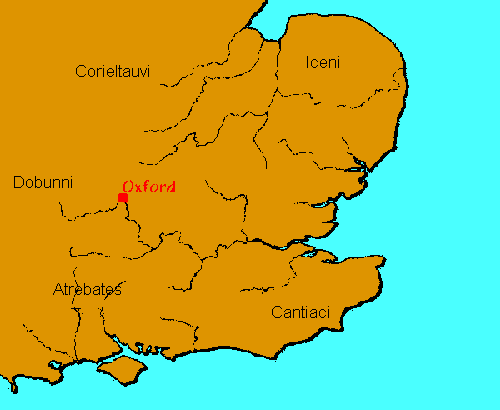| |
Roman Oxfordshire |

The present-day Oxfordshire, with Oxford at its centre, is roughly equivalent to the Upper Thames Valley, the area drained by the upper Thames and its tributaries, forming a network of rivers navigable by small craft. The river gravels were attractive to agriculture: this preceded the Roman occupation and continued after it.
In the lst century BC at the end of the pre-Roman Iron Age, tribal centres were established at Dorchester and Abingdon in the lands of the Atrebates. Here, and indeed north of the Thames floodplain traversed by water channels, the arrival of the Romans was welcomed. Although there may have been a strategically placed fort at Dorchester, the area was glad to be free from the threats of enemy tribes. Akeman Street, running from Cirencester (Roman Corinium) to St Albans (Roman Verulamium) and passing by Alchester, forms an early frontier between this southern protectorate and more hostile lands to the north.
By the 2nd century, the pattern of villas or Romanised farm buildings over the area reflected the widely differing wealth, status and power on the part of the occupants. East of the Cherwell, a string of villas including the ones at Headington Wick and near Abingdon at Barton Court Farm were modest, as were those in the north of the county area at Middleton Stoney and Swalcliffe Lea.
The densest concentration of villas lay to the west in the foothills of the Cotswolds, with villas at Shakenoak, Ditchley, and Great Tew; there were particularly palatial ones at North Leigh and at Stonesfield. A largely agricultural society was dominated by landowners, while the vast bulk of the population worked on the land, predominantly practising agriculture (cattle predominated over sheep; wheat, spelt and flax were grown and supplied the larger towns outside the area), but also extractive industries (Stonesfield slate and Cotswold limestone would have supplied the building trade in the towns) and the pottery industry that grew up and flourished east of the present Oxford between the 2nd and 4th centuries.
© 1998 Oxfordshire Museum Service, Setúbal Museums and the Benaki Museum